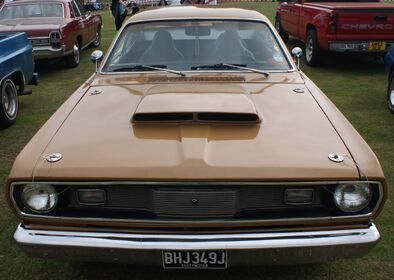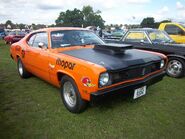
Plymouth Duster
The first Plymouth Duster was a semi-fastback version of the Plymouth Valiant automobile, produced in the US from 1970 to 1976.
The Duster name was later revived for optional trim packages on certain versions of the 1979-1980 Plymouth Volare, 1985-1987 Plymouth Turismo, and 1992-1994 Plymouth Sundance.
History[]
The Duster competed with Ford's slightly smaller semi-fastback Maverick compact that was also introduced in 1970 and the slightly larger semi-fastback Chevrolet Nova whose design was introduced in 1968. While the Maverick and Nova were offered in a 4-door configuration, Chrysler managers used the Duster nameplate only for the 2-door coupe. The traditional Valiant name was retained on the 4-door sedan and 2-door hardtop. The Duster resulted from the Plymouth planning staff's desire to use their allotted 1970 restyling money for something different than the usual two and four-door Valiants. The Valiant platform was used, with front end sheetmetal the same, but completely different from the cowl back. The Duster was also created to fill the slot that was formerly occupied by the Valiant-based Barracuda. When the Barracuda moved from its A-body platform to the new E-body platform in 1970, this left a hole in Plymouth's lineup for a sporty, inexpensive compact.
Numerous variants of the Duster were offered including model names that included Feather Duster, Gold Duster, Silver Duster, Space Duster, Duster Twister, 340 Duster and 360 Duster. The various models targeted customers seeking economy, cargo capacity, or performance.
Year-by-year changes[]
1970[]
The Plymouth Duster introduced in 1970 was all Valiant from the cowl forward, but the rest of the car's sheet metal, save door skins, was completely different. The design incorporated a semi-fastback roof and a special rear valance with twin horizontal taillights, unusual for having no bezels. The door glass was operated by a totally new regulator mechanism, required to fit the much more radical tumblehome (reduced side glass radius), and the windshield was more steeply raked. For 1970 only, a small Valiant badge went on the front fenders just above the Duster badge.
The 1970 Duster was available in two models — the standard Duster and a performance-oriented Duster 340. Engine options were 198 cu in (3.2 L) and 225 cu in (3.7 L) versions of Chrysler's Slant Six, as well as the 318 cu in (5.2 L) and 340 cu in (5.6 L) LA-series V8s.
At midyear, a Gold Duster trim package was added. The Gold Duster package came with either the 225 Slant Six or the 318 V8. It also came with special "Gold Duster" badging, gold stripes on the sides and rear, wall-to-wall carpeting, pleated, all-vinyl seats, whitewalls, wheel covers, a deluxe insulation package, and a canopy vinyl roof. The Gold Duster was offered through 1975. Total sales in 1970 came to 217,192,[2] of which 24,817 were equipped with the 340 engine
1971[]
The Duster was a success for Plymouth, so much so that in 1971 Dodge requested and received their own version, the Demon. In response, Plymouth was given a version of the Dodge Dart Swinger 2-door hardtop named the Plymouth Scamp. For 1971, only small changes were made to the Duster. The "Valiant" fender badges and "Plymouth" grille logotype were deleted. A new trim package was released, called the Duster Twister. The Twister package presented the appearance of the Duster 340, but came only with the base I6 or 318 V8. The Twister's appearance package included special side stripes that mimicked the Duster 340 Wedge stripes, a matte-black hood and the 340's special shark-tooth grille. A nonfunctional dual hood scoop and rear spoiler appearance package was available, as were high-back bucket seats and dual exhaust.
A new Electronic "Breakerless" Ignition became optional on the 340 V8 late in 1971 model year.
1972[]
The Duster was not changed significantly for 1972. New surface-mount sidemarker lights replaced the previous flush-mount items, the taillamps became larger, one-piece units. The power rating of the 340 V8 was reduced from 275 bhp (205 kW) to 245 hp (183 kW) due in part to a reduction in compression ratio from 10.2:1 to 8.5:1, as well as changing the intake valves from 2.02 in (51 mm) to 1.88 in (48 mm). All horsepower rating numbers, even on unchanged engines, decreased for 1972 due to a new rating protocol. Chrysler's electronic ignition became standard on the 340 models in 1972 .
1973[]
Following the design changes on the Valiant models, the Duster also received a new hood, grille, front fenders, bumpers, and taillights for 1973. The taillights on previous years mounted from the inside and had a flush appearance. Starting in 1973, the taillights were mounted from the outside and were trimmed in chrome. These remained unchanged through 1976. New U.S. safety regulations called for 5-mile-per-hour (8.0 km/h) front bumper impact protection that was accomplished through a shock absorbing and stronger bumper rail with rubber guards.
Simpler single-piston slider-type disc brake calipers were introduced for 1973 (standard on 318-powered cars and with power-assist on 340 models), replacing the Kelsey Hayes four-piston calipers. Disc brake-equipped Dusters now had the more-common 5 lugs on 4.5" wheel bolt pattern. All 340 and some 318 engine-equipped cars received the simplified 8.25" rear axle assembly (with wheel bearings riding directly on the axle shaft and endplay being take by C-clips); these axles also featured the 5-on-4.5" wheel bolt pattern. (This axle assembly replaced the 8.75" "drop-out" arrangement seen on some 1966-'72 A-bodies). The 225-powered cars retained the 5 lugs on 4" pattern on vehicles with the standard drum brakes. All models received larger front wheel bearings and increased spindle diameter. Electronic ignition became standard across the board.
A new, metal sunroof was optional for 1973. The rear window defroster/defogger was upgraded to an electric-grid style for 1973, which replaced the previous recessed package shelf air blower.
1974[]
For 1974, Plymouth replaced the 340 with a 360 cu in (5.9 L) version of the corporate LA-series V8, with lower performance due to U.S. government-imposed emissions regulations. The 1974 "E58" 360 engine produced 245 hp (183 kW). New retractable front seat belts were added. In the midst of the first oil crisis, 1974 would be the Duster's best sales year, with a total of 281,378 Duster-bodied cars produced.
1975[]
The 1975 models were mostly unchanged from the previous two years, with some exceptions: a new grille with a return of the Plymouth 3-pointed-'spear' affixed to the grille's center; catalytic converters were added to 225 Slant Six and 318 V8 models (the 360 was not equipped with a converter and its power was now 235 hp (175 kW), due to the addition of a secondary air injection system, commonly referred to as a "smog pump".
1976[]
The grille-mounted park and turn signal lenses were amber; prior years had colorless lenses with amber bulbs. The interior rear view mirror was mounted directly to the windshield rather than to the previous double-pivot roof bracket, and the parking brake was now foot- rather than hand-operated. Disc brakes became standard equipment on cars built after 1 January 1976. Several special models were offered:
Feather Duster featured many lightweight aluminum parts including the intake manifold, bumper brackets, hood and trunk bracing, and manual transmission housing. It came with a 225 Slant Six calibrated for economy, a low-restriction exhaust system, an extra-high rear axle ratio and was offered with either the Torqueflite 3-speed automatic or A833 overdrive 4-speed manual transmission. It was the most fuel-efficient car in its size class, achieving up to 36 mpg (along with Dodge's version, the Dart Lite).
Space Duster version had fold-down rear seat and security panel and combined with the luggage compartment, offered over 50 cu ft (1.4 m3). of cargo space. (This feature was actually introduced, optionally, in 1973).
Silver Duster with special stripes and a cloth Boca Raton style interior. The Duster 360 option was deleted as a separate model as the engine became an option on any trim level Duster. the 1976 360-powered Duster (and Dart Sport 360) was still without a catalytic converter, and its power was down to 225 hp (168 kW).
Popular Culture[]
The artwork for an album released by new wave band The Cars features a Plymouth Duster.





